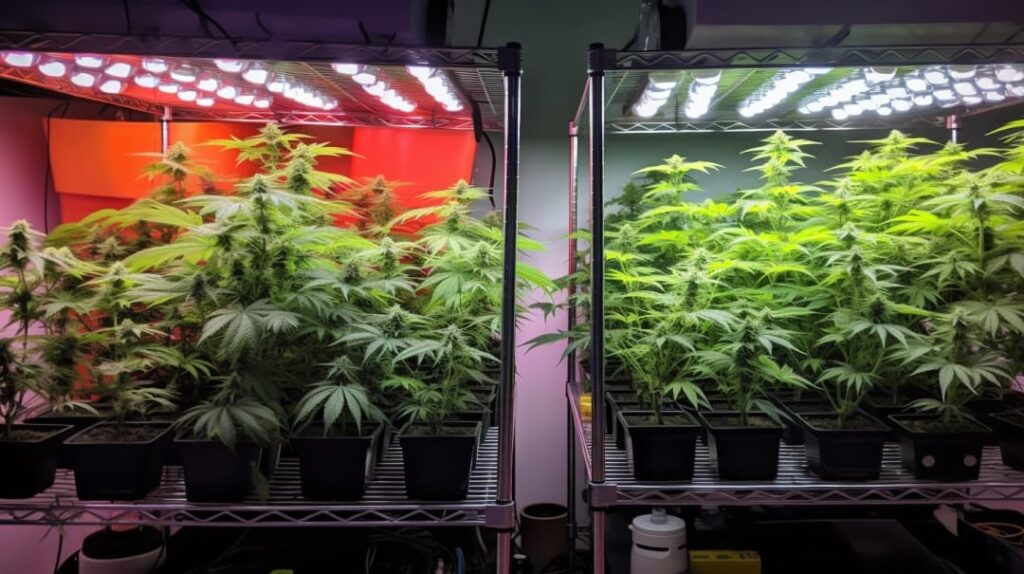Delve into Denver’s cannabis cultivation secrets as we unravel the dynamic dichotomy between indoor and outdoor cultivation. Indoor cultivators employ advanced methods for rapid growth, crafting optimal environments for marijuana plants. Meanwhile, outdoor cultivators embrace natural elements, tapping into the expertise of seasoned marijuana growers.
Explore the nuances of sustainable cannabis cultivation, comparing the benefits and challenges inherent in both indoor and outdoor settings. From controlled conditions to the synergy with nature, this blog unveils the contrasting strategies that shape Denver’s diverse cannabis landscape. Whether you’re a budding enthusiast or a seasoned cultivator, understanding the secrets behind each method adds depth to your appreciation of Denver’s thriving cannabis culture. It’s time to navigate the intricacies of cultivation methods and gain insights into the pulsating heart of Denver’s cannabis scene.
Benefits of Indoor Cultivation
Indoor cultivation offers numerous benefits for cannabis growers in Denver. One advantage is the ability to have complete control over the growing environment. You can manipulate factors like temperature, humidity, and lighting to create the perfect conditions for your plants. This level of control allows for consistent yields and high-quality crops. Another advantage is the ability to grow year-round, regardless of the weather conditions outside. You don’t have to worry about extreme temperatures, pests, or other environmental factors that can negatively impact outdoor cultivation.
However, there are some disadvantages to indoor cultivation as well. It requires a significant investment in equipment, such as grow lights, ventilation systems, and hydroponic setups. Additionally, indoor cultivation consumes more energy, which can increase costs and have an environmental impact. Despite these disadvantages, many growers in Denver find that the benefits of indoor cultivation outweigh the drawbacks.

Advantages of Outdoor Cultivation
When considering cannabis cultivation in Denver, outdoor cultivation offers its own set of advantages. Here are three reasons why outdoor cultivation can be a great choice:
- Cost-effectiveness: Compared to indoor cultivation, outdoor cultivation requires less investment in equipment and energy consumption. This makes it a more cost-effective option for growers, especially for those who are just starting out or have limited resources.
- Natural sunlight: One of the biggest advantages of outdoor cultivation is the access to natural sunlight. Sunlight provides a full spectrum of light that is beneficial for cannabis growth and development. It also allows for more consistent and predictable yields, as the plants can benefit from the natural fluctuations in light intensity and duration.
- Organic cultivation: Outdoor cultivation provides an ideal environment for organic cultivation practices. With the abundance of natural resources, such as soil and water, growers can focus on using organic fertilizers and pest control methods. This not only produces high-quality cannabis but also ensures a more sustainable and eco-friendly approach to cultivation.
Environmental Factors for Indoor Cultivation
Now let’s talk about the environmental factors that play a crucial role in indoor cultivation. One important aspect is the lighting options available for indoor growers, as they need to mimic natural sunlight to promote plant growth. Additionally, temperature control methods are essential to maintain the ideal conditions for cannabis cultivation. These factors, among others, contribute to the success of indoor cultivation and are worth exploring further.
Lighting Options for Indoors
To optimize your indoor cannabis cultivation, it is crucial to carefully consider the lighting options available. The type of lighting you choose can have a significant impact on your plants’ growth and overall yield. When it comes to lighting options for indoor cultivation, two popular choices are LED (Light Emitting Diode) and HID (High-Intensity Discharge) lights. Here are some key factors to consider:
- LED lights:
- Energy-efficient: LED lights consume less energy compared to HID lights, which can help reduce your overall energy consumption and costs.
- Spectrum control: LED lights allow for precise control over the light spectrum, allowing you to tailor the lighting to the specific needs of your plants.
- Durability: LED lights have a longer lifespan compared to HID lights, reducing the need for frequent replacements.
- HID lights:
- High light intensity: HID lights emit intense light, providing ample brightness for cannabis plants to grow and thrive.
- Cost-effective: HID lights are generally more affordable upfront compared to LED lights, making them a popular choice for growers on a budget.
- Heat generation: HID lights tend to generate more heat than LED lights, so proper ventilation and cooling systems are necessary to prevent heat damage to your plants.
Considering these factors, it’s essential to evaluate your specific requirements and budget to determine the most suitable lighting option for your indoor cannabis cultivation.
Temperature Control Methods
Are you wondering how to effectively control temperature in your indoor cannabis cultivation environment? Temperature control is crucial for creating optimal growing conditions and ensuring the health and productivity of your plants. One method for temperature control is using a combination of heating and cooling systems. For heating, you can use electric heaters or radiant heating systems, while for cooling, options include air conditioning units or evaporative coolers.
Implementing humidity control methods such as dehumidifiers or humidifiers can help maintain the ideal moisture levels for your plants. It is also important to consider energy efficiency when selecting temperature control equipment. Look for energy-efficient models and consider using programmable thermostats to regulate temperature settings and reduce energy consumption. By carefully managing temperature and humidity control, you can create a stable and optimized environment for your indoor cannabis cultivation while minimizing energy usage.

Growing Techniques for Outdoor Cultivation
When it comes to outdoor cultivation, you need to consider the optimal growing techniques that will yield the best results. Factors like sunlight exposure, soil quality, and water availability all play a crucial role in the success of your outdoor cannabis crop. Additionally, you must also take into account the weather conditions specific to your region to ensure that your plants receive the right amount of warmth, moisture, and protection throughout their growth cycle.
Optimal Outdoor Growing
If you want to achieve optimal outdoor cannabis cultivation in Denver, you should consider implementing specific growing techniques. Here are some key strategies to help you succeed:
- Choose the right strains: When it comes to outdoor growing, selecting the best strains for the local climate is crucial. Look for varieties that are known to thrive in Denver’s specific conditions, such as Blue Dream, Durban Poison, and Pineapple Express.
- Timing is everything: Start your outdoor grow at the right time of year to maximize the growing season. In Denver, it’s recommended to begin planting in late May or early June, when the risk of frost has passed.
- Provide proper care: Outdoor plants require regular watering, pruning, and pest control. Make sure to monitor moisture levels, trim away any damaged leaves, and protect your plants from pests like aphids or caterpillars.
Weather Considerations for Outdoors?
To optimize your outdoor cannabis cultivation in Denver, ensure you carefully consider the weather conditions. The climate conditions in Denver can be challenging, with hot summers and cold winters. It is important to choose cannabis strains that are suitable for the local climate and can withstand temperature fluctuations. Additionally, proper pest management is crucial in outdoor cultivation. Denver’s diverse ecosystem can attract pests such as aphids, mites, and caterpillars.
Implementing preventive measures like regular inspection and removing any infested plants can help control pest populations. You can also use organic pesticides and companion planting techniques to deter pests naturally. Monitoring the weather forecast regularly and taking appropriate actions like providing shade during scorching heat or using protective covers during unexpected storms will ensure the success of your outdoor cannabis cultivation in Denver.
Quality Control in Indoor Cultivation
You regularly monitor and maintain quality control in indoor cannabis cultivation to ensure optimal results. To achieve this, you focus on two important aspects: pest management and nutrient supplementation.
- Pest Management: Controlling pests is crucial to prevent damage to your cannabis plants. Regular inspections and the use of integrated pest management techniques help identify and address any pest issues promptly. This may involve implementing preventive measures such as proper sanitation, using beneficial insects, or employing organic pesticides when necessary.
- Nutrient Supplementation: Providing the right nutrients is essential for the healthy growth of your cannabis plants. Monitoring nutrient levels and pH balance in the soil or hydroponic system is important to prevent deficiencies or excesses. You carefully follow a feeding schedule and adjust nutrient supplementation based on the specific needs of your plants at different growth stages.
Sustainability in Outdoor Cultivation
Continuing the focus on sustainability, outdoor cultivation offers unique advantages for cannabis production. When it comes to water usage, outdoor cultivation has the potential to be more sustainable compared to indoor cultivation. With outdoor cultivation, plants can rely on natural rainfall and irrigation systems, reducing the need for excessive water usage. This not only conserves water resources but also helps lower operational costs.
In terms of energy consumption, outdoor cultivation requires significantly less energy compared to indoor cultivation. Instead of relying on artificial lighting and climate control systems, outdoor cultivation harnesses natural sunlight and uses the natural environment to support plant growth. This results in reduced energy consumption and a smaller carbon footprint, making outdoor cultivation a more sustainable choice for cannabis production.
Final Thoughts
So, whether you prefer the controlled environment of indoor cultivation or the natural elements of outdoor cultivation, Denver’s cannabis industry has secrets to success for both. From the benefits of indoor cultivation, such as year-round production and quality control, to the advantages of outdoor cultivation, such as sustainability and cost-effectiveness, there are options for every grower. Ultimately, it’s about finding the right balance between environmental factors and growing techniques to produce high-quality cannabis in the Mile High City.


